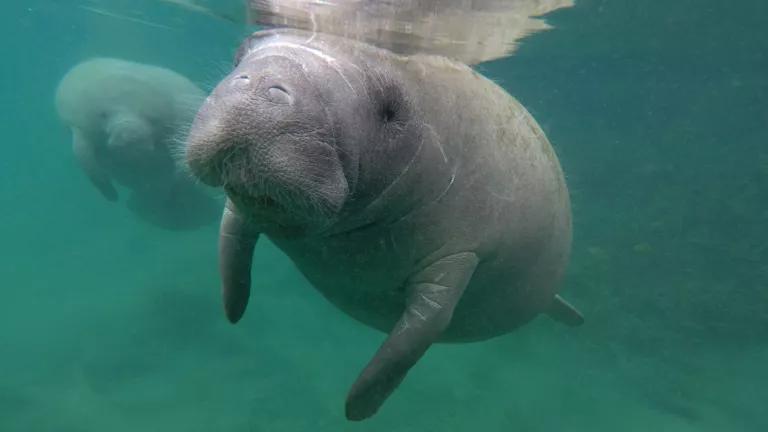Study: Pesticides May Pose Greater Risk to Marine Mammals
A new publication in the journal Science shows manatees and other vulnerable marine and semi-aquatic mammals lack a critical line of biological defense against chlorpyrifos and other pesticides.

Terri Calleson/USFWS
When the Trump administration reversed a planned ban to get the pesticide chlorpyrifos off fruits and vegetables in the U.S. in 2017, it ignored an abundance of scientific evidence establishing the significant risks posed by the pesticide to people and to wildlife. Luckily, today’s court ruling sided with the health of families over the interests of pesticide manufacturers and ordered the Environmental Protection Agency (EPA) to finalize its Obama-era proposed ban on the use of chlorpyrifos on produce sold in the U.S. within 60 days.
But a new study published today in Science highlights another potential danger posed by the common pesticide: marine and semi-aquatic mammals like manatees, whales, dolphins, sea otters, and sea lions lack the key enzyme that can help detoxify chlorpyrifos in the bloodstream.
The study lead, Dr. Wynn Meyer, and coauthors (including me) warn that this missing enzyme may leave these animals at greater risk of harmful effects from exposure to chlorpyrifos and another organophosphate pesticide (diazinon), which contaminate waterways after application to agricultural lands either by leaching into the groundwater or by being carried into nearby waterways with irrigation or rainfall run-off.
Background
The Paraoxonase 1 (PON1) gene encodes the enzyme that works within the bloodstream to reduce damage to lipids, potentially preventing vascular plaque buildup that is associated with health risks including heart attacks and strokes in humans. While humans and other terrestrial mammals have retained this gene and its de-toxifying enzyme, our marine and semi-aquatic mammalian relatives have not, likely as a result of genetic adaptations to different dietary and metabolism demands of life in the water, such as the unique blood flow and oxygen requirements of deep sea diving.
Unfortunately, as marine mammals adapted to aquatic life and lost the ability to produce the PON1 enzyme over time, they also lost the main line of defense that other mammals today employ to combat the neurotoxic effects of exposure to chlorpyrifos and diazinon. And with millions and millions of pounds of these agrochemicals applied to farm land across the country every year, exposure may be inevitable for these animals.
The risk of exposure is particularly pronounced in areas with an abundance of marine mammals and a heavy burden of pesticide application, like Brevard County, Florida, where an estimated 70 percent of Atlantic Coast manatees travel through the warm waterways. In 2015 alone, over 1,000 pounds of chlorpyrifos were applied in Brevard, putting these vulnerable manatees at a high risk of exposure from run-off of the pesticide.

Manatee and map showing adjacency of manatee habitat to agricultural land where chlorpyrifos may be applied in Florida and in Brevard County
NRDC’s History with Chlorpyrifos
The environmental and public health effects of chlorpyrifos have been well known for years. A 2007 petition from NRDC and the Pesticide Action Network compelled the EPA to reconsider the harmful effects of chlorpyrifos exposure to children in light of the growing scientific evidence linking the chemical to human health harms. Following years of rigorous review, EPA announced its intention to cancel all uses of the pesticide on food crops in response to that petition. But in 2017, the Trump EPA abruptly reversed course and denied the petition, clearing the way for chlorpyrifos to continue to poison our food, fields, and waterways.
But today, in a victory for public health ten years in the making, the 9th Circuit Court of Appeals ordered EPA to finalize the proposed ban, halting the application of this toxic pesticide on fruit and vegetable crops sold in the United States.
More Good News
In the absence of federal leadership under the Trump administration, states have been acting to protect families, animals, and the environment from the toxic effects of chlorpyrifos. In June, Hawaii became the first state to ban its use, and California released a report confirming the dangers chlorpyrifos poses to children in a report released in July.
The Bottom Line
With the publication of the Meyer study, the evidence continues to mount against the use of this popular pesticide, and NRDC will continue to fight until our people and our planet are protected from this dangerous chemical.



